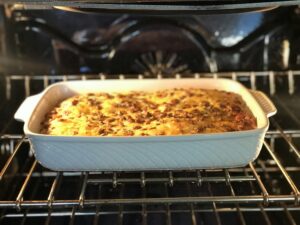The aroma of a freshly baked perfect breakfast casserole wafting through the air is a hallmark of cozy weekend mornings. It is also an indicator of festive brunch gatherings. This comforting dish is versatile, i.e., a myriad of ingredients—eggs, cheese, meats, and vegetables—all nestled in one bake. Yet, despite their popularity and seemingly straightforward preparation, many home cooks encounter a common and frustrating issue: a soggy breakfast casserole. Instead of achieving a balanced dish with a crispy top and a firm base, they find themselves facing a watery mess.
Understanding Casserole Sogginess
A soggy breakfast casserole can be the bane of a home cook’s existence, turning what should be a delightful meal into a disappointing, mushy mess. The key to avoiding this culinary pitfall lies in understanding the various factors that contribute to excessive moisture:
Ingredients with High Water Content:
The inclusion of vegetables like zucchini, mushrooms, and spinach is common in many casserole recipes for their nutritional value and flavor. However, these ingredients are also high in water content. As they cook, they release moisture into the surrounding dish, which can accumulate and result in a soggy texture. It’s crucial to manage these ingredients properly to maintain the integrity of your casserole.
Overcooked Starches:
Starches such as noodles or rice act as the backbone of many casseroles, providing structure and substance. When these elements are overcooked before being added to the casserole, they become overly absorbent. Instead of contributing to the dish’s firmness, they soak up moisture like a sponge, exacerbating the sogginess. Achieving an al dente texture is essential to prevent this issue.
Insufficient Baking Time or Incorrect Temperature:
The cooking process plays a pivotal role in making perfect breakfast casserole. An oven that’s not hot enough or a baking time that’s too short won’t allow excess moisture to evaporate properly. This can leave you with a dish that’s more akin to a stew than the intended hearty, baked casserole. Conversely, an oven temperature that’s too high can cause the top to brown too quickly, leaving the interior undercooked and wet.
Improper Layering or Ingredient Ratios:
The way you layer your casserole and the proportions of each ingredient can also impact the dish’s moisture level. An imbalance, such as too much sauce or not enough solid components, can lead to a dish where the liquid elements dominate, resulting in a soggy texture.
Covering Technique During Baking:
Covering your casserole with foil can be a double-edged sword. While it helps to prevent the top from burning, it can also trap steam within the dish. Consequently, it contributes to an overly moist environment. Knowing when to cover and when to uncover your casserole is key to achieving the perfect balance of moisture.
Understanding these causes is the first step toward m
astering the art of the perfect breakfast casserole. By adjusting your preparation and cooking techniques accordingly, you can ensure that your dish turns out deliciously firm. This consideration keeps them free from the dreaded sogginess that plagues many a breakfast table.
Common Mistakes Leading Not so Perfect Breakfast Casserole
Mistake #1: Overcooked Noodles or Rice
One of the cardinal sins in casserole preparation is allowing noodles or rice to surpass the al dente stage before they’re added to the mix. This over-preparation transforms these starches into excessive moisture absorbers during the baking process, significantly contributing to a soggy texture that detracts from the desired casserole experience.
- Solution: The key to avoiding this pitfall is to meticulously monitor the cooking time of these starches, reducing it by 1-2 minutes less than what’s suggested on the package. This ensures they retain a firm texture, perfectly poised to soak up the right amount of moisture without becoming mushy. It’s a delicate balance to strike, but achieving this al dente perfection is crucial for a casserole that’s satisfyingly cohesive, with each bite delivering the ideal blend of flavors and textures. Consider experimenting with different types of noodles or rice to see which best maintains its structure during baking, further enhancing your casserole’s integrity.
Mistake #2: Burnt Toppings
A crispy topping is not merely a textural delight in a breakfast casserole; it’s a critical component of the dish’s overall sensory appeal. Yet, the quest for that perfect golden crust can sometimes lead to burnt toppings, overshadowing the casserole’s flavors and dampening the dining experience.
- Solution: Achieving the perfect breakfast casserole without burning the topping involves strategic oven placement and timing adjustments. Positioning the casserole on the oven’s center rack promotes even heat distribution, while covering the dish with foil for the initial baking phase protects delicate toppings like cheesy layers or crispy breadcrumbs. This approach allows the interior to cook thoroughly without the top becoming overly browned. Monitoring and adjusting the baking time based on your oven’s specific characteristics can also prevent burning, ensuring that your casserole’s topping is irresistibly crunchy yet never charred.
Mistake #3: Excess Moisture from Vegetables
Incorporating vegetables into a breakfast casserole introduces a spectrum of flavors and textures, as well as a boost of nutrition. However, vegetables like zucchini, mushrooms, and spinach can also unwittingly contribute excess moisture, leading to a less-than-desirable soggy outcome.
- Solution: The strategy to mitigate this moisture issue lies in the preliminary treatment of these vegetables. Sautéing or roasting them before adding to the casserole allows for a significant reduction in their water content, concentrating their flavors and ensuring they enrich the dish without compromising its texture. For vegetables that release a lot of water, such as zucchini, employing techniques like salting and draining can be remarkably effective. This not only draws out excess moisture but also seasons the vegetables, layering additional flavor into your casserole. Remember, the goal is to celebrate the vegetables’ contribution to the dish without allowing them to dilute its quality.
Mistake #4: Lack of Flavor, a Huge Hindrance to Perfect Breakfast Casserole
A bland casserole is a missed opportunity to delight the palate. The complexity of flavors in a breakfast casserole can be muted by the cooking process, necessitating thoughtful seasoning and the incorporation of flavor enhancers.
- Solution: Elevating the flavor profile of your casserole involves more than just salt and pepper. Incorporating herb oil, citrus zest, or a dash of hot sauce can introduce vibrant notes that cut through the richness of the dish. These additions not only enhance the taste but also contribute to a more aromatic experience, making each serving more enticing. Consider layering flavors by using a variety of herbs and spices tailored to complement the main ingredients of your casserole. A drizzle of high-quality olive oil or a sprinkle of fresh herbs before serving can also add a final touch of freshness, elevating the dish from good to unforgettable.
Mistake #5: Dryness
Conversely, the fear of creating a soggy casserole can sometimes lead to an overly dry dish. This imbalance often results from an incorrect ratio of solid to liquid ingredients or overcooking.
- Solution: Introducing a creamy layer or additional moisture-rich ingredients such as marinara sauce or a simple béchamel can reintroduce moisture in a controlled manner, ensuring the casserole remains moist without becoming soggy. Ingredients that naturally contain fats, like certain cheeses, can also help maintain a moist texture throughout the baking process. Serving the casserole with a side of sauce can provide diners with the option to adjust the moisture level to their preference.
Mistake #6: Total Failure
At times, despite all efforts, a casserole may not turn out as expected. It’s crucial to view these instances not as total failures but as valuable learning experiences.
- Solution: Reflecting on what might have gone wrong is the first step toward improvement. Was the recipe followed correctly? Were the ingredients of good quality? Did the baking time and temperature align with the recipe’s requirements? Answering these questions can provide insights for future attempts. Remember, cooking is as much about experimentation and adaptation as it is about following recipes. Embrace the journey, and know that every mistake gives an opportunity to learn and eventually master the art of making perfect breakfast casserole.
Step-by-Step Guide to Perfect Breakfast Casserole
Achieving the perfect breakfast casserole is about more than avoiding mistakes; it’s about mastering a series of steps that ensure success from preparation to serving.
Preparation Techniques for Perfect Breakfast Casserole
- Par-cooking: Essential for ingredients like noodles and rice. This step ensures they’re just the right texture before being added to the casserole, capable of absorbing some moisture without becoming mushy.
- Draining and Salting: For vegetables with high water content, this process is crucial. It helps remove excess moisture that could contribute to a soggy texture. After salting, let them sit for a bit, then rinse and thoroughly drain or pat dry before use.
Layering for Success
- The order in which you layer your ingredients can impact the final texture of your casserole. Start with a layer of your par-cooked starch as a base. Then, add your protein and vegetables, ensuring that any moisture-rich ingredients are evenly distributed to prevent soggy spots.
- Balance is key. Ensure there’s enough moisture to cook the ingredients through without drowning them. This might mean adjusting the amount of liquid based on the water content of your vegetables and the absorbency of your starch.
Crisp Breakfast Casserole Tips
- The position of your casserole in the oven can affect how it cooks. Placing it on the center rack ensures even heat distribution, reducing the risk of a burnt top or an undercooked base.
- If your casserole has a tendency to brown too quickly on top, covering it with foil for part of the bake time can protect it while allowing the inside to cook thoroughly. Remove the foil towards the end of baking to allow the top to crisp up.
Enhancing Your Casserole
To elevate your breakfast casserole from good to great, consider these additional tips for enhancing flavor and texture.
Flavor Boosters
- Don’t underestimate the power of fresh herbs and spices. A well-chosen spice blend can transform a simple casserole into a dish bursting with flavor.
- Consider finishing your casserole with a sprinkle of fresh herbs or a zest of citrus before serving. These can add a fresh, bright note that lifts the entire dish.
Moisture Management
- A balance of moisture is crucial for a perfect casserole. If you find your dishes are consistently too dry or too soggy, consider adjusting the amount of liquid ingredients or the bake time and temperature.
- Experiment with adding a creamy layer such as a béchamel sauce or a dollop of crème fraîche in the middle of the casserole. This can add moisture and richness without making the dish overly wet.
FAQs: Mastering the Perfect Breakfast Casserole
Q: How can I prevent my casserole from being too watery?
The key to preventing a soggy breakfast casserole lies in managing the moisture content of your ingredients and cooking process. Here are a few strategies:
- Pre-cook high-water content vegetables: Vegetables like zucchini, mushrooms, and spinach release moisture as they cook. Pre-cooking these and draining any excess liquid can significantly reduce the water they contribute to the casserole.
- Adjust liquid ingredients: If your recipe includes liquid components, consider reducing the amount slightly, especially if you’re adding moisture-rich vegetables or meats.
Q: What are the best vegetables to use in a breakfast casserole?
Choosing the right vegetables for your casserole can enhance its flavor, texture, and nutritional content without adding unwanted moisture:
- Low-moisture vegetables: Options like bell peppers, onions, and root vegetables (e.g., potatoes, carrots) contribute less moisture and hold up well during baking.
- Pre-cooked high-moisture vegetables: For vegetables with high water content, pre-cooking and draining them before adding to the casserole can mitigate moisture issues. This allows you to enjoy the flavors of spinach, mushrooms, and zucchini without the sogginess.
Q: Can I make my casserole ahead of time without it getting soggy?
Yes, with proper preparation, you can make a breakfast casserole ahead of time:
- Cool ingredients: Allow cooked ingredients to cool before assembling the casserole. This prevents steam from getting trapped inside, which can contribute to a soggy texture upon reheating.
- Refrigerate before baking: If you’re preparing the casserole ahead of time, assemble it, cover it tightly, and refrigerate. Bake it fresh when you’re ready to serve for the best texture and flavor.
Conclusion: Perfect Breakfast Casserole
Creating the perfect breakfast casserole is an art that balances flavors, textures, and moisture. By understanding the common pitfalls and mastering the techniques to avoid them, you can ensure your casseroles are always a hit. Remember, experimentation and adaptation are key to culinary success. So, don’t be afraid to tweak recipes and make them your own. With these tips and tricks, your breakfast casseroles will never be soggy again.



